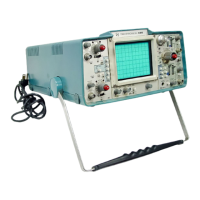Mai ntenance—455/ A2/B2
CORRECTIVE MAINTENANCE
Corrective maintenance consists of component replacement and instrument repair. Special techniques required to replace
components in this instrument are given here.
OBTAINING REPLACEMENT PARTS
Standard Parts
All electrical and mechanical part replacements for this
instrument can be obtained through your local Tektronix
Field Office or representative. However, many of the
standard electronic components may be available locally in
less time. Before purchasing or ordering replacement parts,
check the parts list for value, tolerance, rating and description.
NOTE
Physical size and shape o f a component may
affect Instrument performance, particularly at
high frequencies. Always use direct-replacement
components, unless you know that a substitute
will not degrade instrument performance.
Special Parts
In addition to the standard electronic components, some
special components are used in this instrument. Some
components are manufactured or selected by Tektronix, Inc.
to meet specific performance requirements. Others are
manufactured for Tektronix, Inc. according to our specifica
tions (see Cross Index Manufacturers Code Number to
Manufacturer in Electrical Parts List for code numbers).
Most of the mechanical parts used in this instrument have
been manufactured by Tektronix, Inc. Order all special
parts directly from your local Tektronix Field Office or
representative.
Ordering Parts
When ordering replacement parts from Tektronix, Inc.,
include all of the following information to insure receiving
the proper parts.
1. Instrument type (include modification or option
numbers).
2. Instrument serial number.
3. A description of the part (if electrical, include the circuit
number). 4
4. Tektronix part number.
SOLDERING TECHNIQUES
WARNING I
To prevent electrical shock or damage to the
instrument, always disconnect the instrument
from the power source before soldering.
Use ordinary 60/40 solder and a 15 watt pencil-type solder
ing iron for most soldering. Using a soldering iron with
higher wattage-rating on etched circuit boards can cause the
etched circuit wiring to separate from the board base
material.
The following technique should be used to replace a com
ponent on the circuit board. Most components can be
replaced without removing the boards from the instrument.
1. Grip component lead with long-nose pliers. Touch
soldering iron to lead at solder connection. Do not lay iron
directly on board.
2. When solder begins to melt, pull lead out gently. This
should leave clean hole in board. If not, hole can be
cleaned by reheating solder and placing sharp object (e.g.
toothpick) into the hole to clean it out. A vacuum-type
desoldering tool also can be used for this purpose.
3. Bend leads of new component to fit holes in board. If
component is replaced while board is mounted in instru
ment, cut leads so they just protrude through board. Insert
leads into holes in board with component firmly seated
against board (or as positioned originally). If it does not
seat properly, heat solder and gently press component into
place.
4. Touch the iron to the connection and apply a small
amount of solder to make a firm solder joint. To protect
heat-sehsitive components, hold the lead between the com
ponent body and the solder joint with a pair of long-nose
pliers or other heat sink.
5. Clip excess lead that protrudes through board (if not
clipped in step 3).
6. Clean area around solder connection with flux-remover
solvent.
REV. A, OCT 1975
5-3

